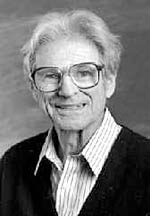Prize Recipient

Edwin Ernest Salpeter
Cornell University
Citation:"For wide-ranging contributions to nuclear and atomic physics and astrophysics, including the triple-alpha reaction, electron screening of nuclear reactions, charged-current emission of neutrinos, and the form of the stellar initial mass function."
Background:
Dr. Salpeter is a native of Austria but fled from Hitler to Australia in 1939 where he received his BS in physics and mathematics in 1944 from Sydney University. In 1948, he received his Ph.D. in theoretical physics from Birmingham University
Dr. Salpeter began his career in 1949 at Cornell University as a research associate under Hans A. Bethe and remained at Cornell as a Professor, eventually becoming the J. G. White Distinguished Professor of Physical Sciences (Emeritus since 1997). In the 1950's, he worked with Prof. Bethe on atomic theory and quantum electrodynamics, developing the so-called "Bethe-Salpeter equation" and publishing book entitled "Quantum Mechanics Of One- And Two Electron Atoms."
Other areas of research for Dr. Salpeter have been nuclear astrophysics, stellar evolution and the statistics of star formation, statistical mechanics and plasma physics (electron screening and ionospheric backscatter), condensed matter physics of Jupiter's interior and interstellar dust grains, biophysics of synapses and the mathematical epidemiology of tuberculosis.
Dr. Salpeter is a member of professional societies in physics, astronomy and epidemiology. He also has received numerous awards and recognition, including four honorary doctorates, the RAS Gold Medal, the AAS Russell Lectureship, the ASP Bruce Medal, the Oppenheimer Memorial Prize, the De Vaucouleurs Medal from the University of Texas, the Dirac Memorial Medal from the University of NSW, and the Crafoord Prize for 1997.
Selection Committee:
Virginia Trimble (Chair), John P Schiffer, John N. Bahcall ('98 Recipient), John D. Walecka (Vice Chair), Wick C. Haxton
